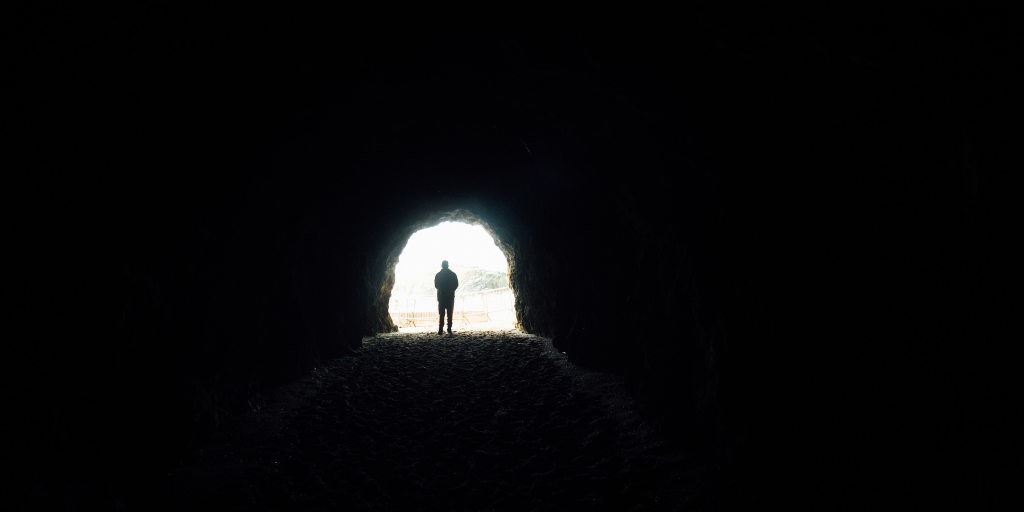What are near-death experiences (NDEs), materialistic explanations of NDEs, how Christians should discern between true and false NDEs, and how near death experiences point to certain death.
This article originally appeared on AnswersInGenesis.org and won a Higher Goals 2021 award from the Evangelical Press Association (EPA).
Everyone wants to know what happens when we die. As the Christian fabric of our society continues to unravel, many are reaching for answers beyond the grave in areas where the Bible spoke in former times. The interest has been met by many interviews, studies, and articles about near-death experiences (NDEs). The European Academy of Neurology analyzed participants from 35 countries who reported something like a near-death experience. They found that 1 in 10 people have experienced a near-death experience. There are many stories to tell.
Eben Alexander, M.D., wrote Proof of Heaven: A Neurosurgeon’s Journey into the Afterlife. According to Amazon, Dr. Alexander knew that near-death experiences felt real, but he thought the brain produced fantasies under extreme stress. Then, a rare illness attacked Dr. Alexander’s brain. For seven days he lay in a coma. As his doctors considered stopping treatment, Alexander’s eyes popped open. He had come back. Alexander’s story of what he supposedly saw was published and it became a 2012 New York Times #1 Best Seller. People are fascinated by these stories. In essence, how are we to understand near-death experiences as believers in Jesus?
Though we know there is much interest in near-death experiences, do we know how to think about them as Bible-believing Christians? What are these phenomena? Does the Bible mention them? How can we separate fact from fiction? In essence, how are we to understand near-death experiences as believers in Jesus?
What are Near-Death Experiences (NDEs)?
The University of Virginia (UVA) School of Medicine defines an NDE as “a common pattern of events that many people experience when they are experiencing intense threat, are seriously ill, or come close to death. UVA School of Medicine also found NDEs can include the following reported experiences:
- Comfortable feelings without pain
- Sensations of leaving the body, sometimes with the ability to see their own physical body
- Quickly functioning, sharp minds
- Sensations of being drawn into darkness or a tunnel
- An intense light
- Sensations of peace, well-being, or complete love
- Remembering important past events
- Previews of future events
- Encounters with deceased family, friends, or religious figures
Almost unnoticed in the euphoria about them has been the sobering fact that not all NDEs are so affirming. Some are deeply disturbing.
According to those who study the phenomena in the medical community, NDEs are generally affirming experiences. However, not all near-death experiences are positive. Nancy Evans Bush, President Emerita, International Association for Near-Death Studies and Bruce Greyson, MD, co-authored a 2016 article for the National Institutes of Health, “Distressing Near-Death Experiences: The Basics.” Bush and Greyson explain, “The great majority of near-death experiences (NDEs) reported publicly over the past four decades have been described as pleasant, even glorious. Almost unnoticed in the euphoria about them has been the sobering fact that not all NDEs are so affirming. Some are deeply disturbing. Few people are forthcoming about such an event; they hide; they disappear when asked for information; if inpatient, they are likely to withdraw; they are under great stress.”
In the same study, Bush and Greyson categorized distressing near-death experiences in three ways. Here is an example of each one:
- Inverse: “In some NDEs, features usually reported in other NDEs as pleasurable are perceived as hostile or threatening. A man thrown from his horse found himself floating at treetop height, watching emergency medical technicians working over his body. ‘No! No! This isn’t right!’ He screamed, ‘Put me back!’ but they did not hear him.”
- Void: “A woman in childbirth found herself abruptly flying over the hospital and into deep, empty space. A group of circular entities informed her she never existed, that she had been allowed to imagine her life but it was a joke; she was not real. She argued with facts about her life and descriptions of Earth. ‘No,’ they said, ‘none of that had ever been real; this is all there was.’ She was left alone in space.”
- Hellish: “A woman who hemorrhaged from a ruptured Fallopian tube reported an NDE involving ‘horrific beings with gray gelatinous appendages grasping and clawing at me. The sounds of their guttural moaning and the indescribable stench still remain 41 years later. There was no benign Being of Light, no life video, nothing beautiful or pleasant.’”
Not surprisingly, distressing NDEs are not as well publicized in a culture that seems attuned to more positive messages. Because distressing near-death experiences are more difficult to record, it would be unwise to speculate how many NDEs are positive or negative based on reports.
Near-Death Experiences in the Bible
Arriving at the Bible, we find scant information about near-death experiences. There are at least ten people raised from the dead in Scripture. Some of those raisings include Elijah raising the son of the Zarephath widow from the dead (1 Kings 17:17–22), the dead man who was raised when his body touched Elisha’s bones (2 Kings 13:20, 21), Jesus rising from the dead (Matthew 28:5-8; Mark 16:6; Luke 24:5, 6), and Dorcas being brought back from the dead (Acts 9:36-41). The interesting thing about these people who came back is the lack of information about the other side. This doesn’t mean they didn’t experience anything extraordinary. But aside from Jesus’ post-resurrection testimony, we don’t see any statements from people who experienced an NDE in the Bible.
The closest thing we uncover to a near-death experience in Scripture is Stephen’s martyrdom in the book of Acts. In Luke’s account, we read about a stressful situation preceding death which often accompanies NDEs in the scientific literature:
The closest thing we uncover to a near-death experience in Scripture is Stephen’s martyrdom in the book of Acts.
But he, full of the Holy Spirit, gazed into heaven and saw the glory of God, and Jesus standing at the right hand of God. And he said, “Behold, I see the heavens opened, and the Son of Man standing at the right hand of God.” But they cried out with a loud voice and stopped their ears and rushed together at him. Then they cast him out of the city and stoned him. And the witnesses laid down their garments at the feet of a young man named Saul. And as they were stoning Stephen, he called out, “Lord Jesus, receive my spirit.” And falling to his knees he cried out with a loud voice, “Lord, do not hold this sin against them.” And when he had said this, he fell asleep. (Acts 7:55–60)
In this narrative, we find Stephen’s eyes being open to events in heaven just before he was killed. This supernatural revelation was an unveiling of a celestial scene where the Trinity was at work and on display. Stephen, through the Holy Spirit, saw both Jesus and God the Father in heaven. Because this event is recorded in Scripture, we know a near-death experience can reveal glimpses of a real heaven. In other words, legitimate near-death experiences are possible and could be used by God as they align with Scripture.
Materialistic Explanations of Near-Death Experiences
Despite the popular interest and literature documenting near-death experiences, atheistic materialists have attempted to explain away the phenomena. Materialists believe that matter is all that exists and thus immaterial souls are not real nor is a spiritual realm. There are several explanations materialists posit to explain away near-death experiences as physical anomalies.
Dr. Peter Fenwick is consultant neuropsychiatrist at the Maudsley Hospital in the UK and presides over the International Association for Near-Death Studies. Fenwick built a database of over 300 NDE accounts. The Christian Medical Fellowship analyzed the research and addressed some common materialist explanations for near-death experiences and how they don’t always work.
- Hallucinations: Unlike NDEs, hallucinations are renowned for their subjective content. Despite some similarities with hallucinations, NDEs are more varied and include different cultural elements not always common with erratic hallucinations.
- Drugs: Drugs are often administered as part of a resuscitation attempt and could disorder brain function and produce an NDE. However, only 14% in Dr. Fenwick’s database had been given drugs at the time of their experience.
- Endorphin-related: The body’s own pain-killing endorphins could induce a sense of euphoria, leading to an NDE. For instance, there is a surge of endorphins following grand mal seizures, but the effect is not positive and coherent visions are usually not reported.
- Cerebral hypoxia: Some have postulated that low oxygen might cause random firing of neurons in the visual system. This experience could result in a central dot of light that spreads out to the peripheries of vision appearing to be movement down a tunnel of light. However, those who experience cerebral hypoxia in other situations (like fighter pilots), do not experience NDEs.
Though some near-death experiences could be explained away by materialistic interpretations, it’s difficult to resolve the thousands of otherworldly experiences in an atheistic and materialistic worldview. On the other hand, it is easier to understand NDEs from a Christian perspective in a world constructed by God, populated by immaterial souls, created with other spiritual beings and other realms including heaven and hell.
Fact & Fiction with NDEs
But this does not mean we should accept all near-death experiences. After all, there is big money in so-called “heavenly tourism.” In 2010, Kevin and Alex Malarkey wrote, The Boy Who Came Back from Heaven. The duo recounted the NDE of a six-year old (Alex) who suffered a horrific accident, was paralyzed, and unlikely to survive. While he lay unconscious in the hospital, Alex supposedly visited heaven, saw angels, heard unearthly music, and met Jesus. The book sold more than a million copies. Turns out, it didn’t happen.
Five years after it was published, the young author recanted his story even though his father still sought to profit from the tale. In an open letter to booksellers, Alex said he made it up to get attention. The story was a lie. One of the largest booksellers of the fable, Lifeway Christian Stores, eventually pulled the remaining copies from the shelves, but not before hundreds of thousands of people had believed a tale told by a boy named Malarkey.
Clearly, we cannot believe every near-death experience. Some people who describe NDEs may be motivated by attention like Alex. Others could have a financial motivation. The 2014 movie, Heaven is for Real, was about a young boy who slipped into unconsciousness during emergency surgery, supposedly visited heaven, and met deceased loved ones along with Jesus. The movie grossed over $100 million dollars! This doesn’t mean the movie wasn’t based on a true story, but we should recognize there are monetary incentives to promote a compelling near-death experience, even if there are other seemingly positive outcomes or reasons to tell the story.
Clearly, we cannot believe every near-death experience.
Christians should value truth over any possible confirming experience in an NDE (John 8:32). After all, we don’t need anecdotal evidence of what we know is true from Scripture. When we come across a seemingly credible account of someone who may have had a near-death experience, we must weigh the account against more reliable information. Here are a three, biblical questions that will shed light on whether a near-death experience is legitimate.
- Is the person generally trustworthy (Luke 16:10)?
- Was there a long-lasting, positive change in the person’s life as a result of the NDE that can be supported by family and friends (Deuteronomy 19:15–21)?
- Does the NDE conform to what Scripture says about the events reported (2 Peter 1:19)?
Answering yes to all these questions lends credence to a possible near-death experience. However, these questions do not guarantee any near-death experience actually happened. If any of the events or descriptions contradict what we know is clearly taught in Scripture, we must reject these accounts or attribute them to other malicious causes. Ultimately, we should not depend on any fallible person’s subjective experience about eternal matters.
Biblical Truth Trumps NDEs
As in everything else, the Bible is the most authoritative source for information on this life and the life to come. Near-death experiences are, by nature, subjective events that happen to one person. God knows why they happen. If they are from him, they may be specifically for that individual. Perhaps God may even use such an experience to draw people to himself. Though some may be true, we cannot be absolutely certain about any given NDE. Subjective experience must never overrule the clear teaching of the Word of God, which is our only sure foundation.
As in everything else, the Bible is the most authoritative source for information on this life and the life to come.
The Apostle Peter wrote, “And we have the prophetic word more fully confirmed, to which you will do well to pay attention as to a lamp shining in a dark place . . .” (2 Peter 1:19). Peter informs us that the “prophetic word” should confirm our experiences. This includes near-death experiences. This is true of regarding our own NDEs, “visions,” etc., if we have them, or of others’ experiences.
In the context of what we should expect when we die, the Bible tells us every person is appointed to die and will be judged (Hebrews 9:27). The only way to get right with God is through Jesus who said, “I am the way, and the truth, and the life. No one comes to the Father except through me” (John 14:6). Whoever truly believes in Jesus for the forgiveness of sins will not perish but have everlasting life (John 3:16). These things are sure.
On the other hand, near-death experiences are not as sure. After all, we live in a spiritual world. Fallen angels can misdirect people—even Christians. Paul warns the Corinthian believers about Satan’s schemes when he wrote, “And no wonder, for even Satan disguises himself as an angel of light” (2 Corinthians 11:14).
So it is possible for people to be led astray in a near-death experience by malevolent spirits who appear benevolent but are actually bent on deceiving them.
A near-death experience seems to bring people closer to the spiritual realm. So it is possible for people to be led astray in a near-death experience by malevolent spirits who appear benevolent but are actually bent on deceiving them. This arena can be Satan’s playground where he is the “prince of the power of the air” (Ephesians 2:2). Because NDEs could be influenced by demonic spirits, our understanding of them must be informed by Scripture.
Conclusion: Near-Death Experiences Point to Certain Death
In conclusion, near-death experiences point to a reality we must all face: death. Ever since Adam and Eve sinned in the Garden of Eden (Genesis 3:1-7), every person who lived before us has died. Death is one of the unifying realities in humanity (Romans 5:12). NDEs generate immense interest in a world where everyone dies.
Near-death experiences point to a world beyond our own. Whether any particular near-death experience is a reliable experience from God can be challenging to discover. However, one thing remains true of everyone: we will all die. And there is only one rescue from a just and eternal judgement: repenting and believing the good news of Jesus Christ.
Photo by Tim Foster on Unsplash.








